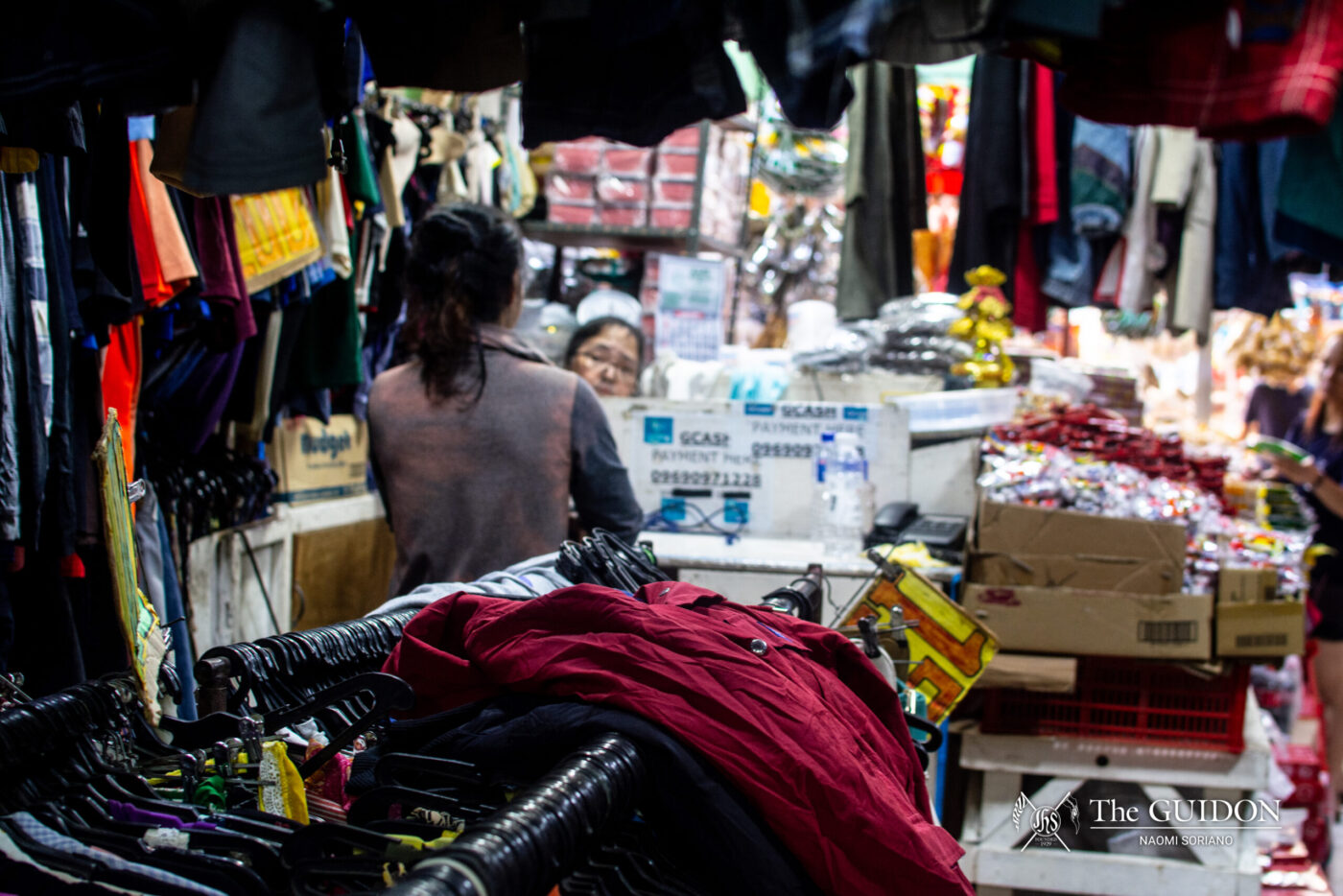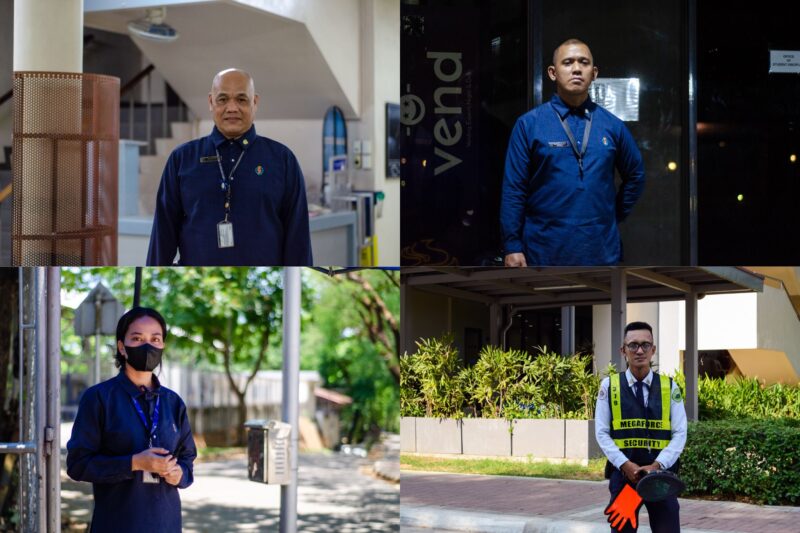Ukay-ukay workers Ate Lisa and Kuya Arnold share what life is like as those responsible for keeping many Filipinos clothed.
WHEN YOU set foot into an ukay–ukay, the infinite rows of garments and neon green hangers immediately make themselves impossible to ignore.
Browsing through the clothes, you may be wondering why that graduation shirt from an American high school made the thousand-mile trip to your hands. The thought of someone discarding a sweater emblazoned with their grandmother’s face may sound perplexing. All the while, the old radio blasts out some nostalgic karaoke tunes—a fitting soundtrack for a trip through sartorial history.
Once your excursion into the store comes to an end, one thing is sure: you have, in a sense, seen glimpses of the lives of complete strangers. Such an experience is made possible by the places that such storied clothes have been gathered in, as well as the hands that tire to keep these stores stocked.
Unfortunately, ukay-ukay workers’ own stories are often overshadowed by the years of memories locked in the sweat, wrinkles, and tears of the garments they sell. These workers’ stories deserve the same regard and remembrance they give to such timeless fabrics.
A labor of love
Thrift shopkeeper Ate Lisa’s story began not long after the turn of the century. Hailing from Bohol, she describes her life on the island-province as difficult, having tirelessly farmed and fished to put food on the table.
As a single mother seeking greener pastures for her three children, Ate Lisa relocated to Manila City in April 2007 with little more than a few belongings and a loving heart. Far from home, she shares that her immediate concerns at the time consisted of employment, lodgings, and sustenance.
Fortunately, Ate Lisa found the answer to all in one establishment in downtown Manila—the Ansan General Merchandise. “Mayroon silang bahay para sa mga nagtatrabaho. Libre pa ‘yung pagkain. So, maganda talaga,” she says.
(They have a house for their employees, and the food is free. So, it’s really nice.)
Since then, Ate Lisa has remained a loyal employee of Ansan. She opens the store at 10 AM every day, replenishes the racks, and determines pricing.
On the other hand, ukay-ukay owner Kuya Arnold’s thrifting endeavors started as the serendipitous discovery of an unexpected passion.
Kuya Arnold’s venture began in 2016 as a customer. His encounters from the other side of the counter shaped the path he would commit to for the foreseeable future. “Noong una, hindi ako interested na mag-ukay lang, pero noong nakita ko na ganito pala mga taong mahilig sa ukay, na-enganyo ako (At first, I wasn’t interested in working in a thrift shop, but when I saw how it was and the community around it, I was enticed),” he elaborates.
Enamored by ukay-ukays’ quaintness, Kuya Arnold began learning the ropes of the business as a salesman for other thrift stores. After three years of toil, Kuya Arnold was able to save up and gain experience from his work, eventually opening his own Anonas-based ukay-ukay, AG&M Fashion Shop.
Even with a place to call his own, though, Kuya Arnold finds that little has changed since his days as an employee. His responsibilities, such as watching over the store, interacting with buyers, and managing AG&M’s social media pages, are not a far cry from those carried out by hands like Ate Lisa.
For Kuya Arnold and Ate Lisa, the ukay-ukay has become more than just the worn clothes inside. In a sense, their businesses have provided them both with a channel through which their love is embodied. In Ate Lisa’s situation, the ukay-ukay serves as an avenue for her to keep her own family well-fed, sheltered, and clothed. On the other hand, Kuya Arnold’s business blends passion with practicality—components of a satisfying work life.
Customers from all around
Besides the work of the employees and owners who manage the shop, their business would not run without its customers. In Ansan, the suki (regular customers) are not of a specific demographic. The buyers flowing in and out of the shop are of varying ages, social classes, and backgrounds. According to Ate Lisa, some even travel from places such as Ilocos and Batangas all the way to Quiapo, Manila.
She recalls a time when a customer from China visited the shop. “[Sabi nila,] ‘Ay gusto namin [dito] kasi mura.’ Ito, [kung] bibilhin [nila] doon sa country nila, mahal,” she says.
(They said they like how cheap it is here. If they bought it in their country, it would be expensive.)
The shop also highly values its regular customers who frequently visit the shop when running errands around the area. Beyond the affordability of their items, good quality pieces and hidden gems motivate buyers to return in search of their next good find.
Kuya Arnold finds that seeing his suki has become a part of his job which he looks forward to. He describes these customers fondly. “Makukulit [sila], pero at least, parang naging close close na rin naman ‘yung mga suki eh, malaking pasalamat ko din kasi kung wala naman sila, wala rin kami,” he shares.
(They are stubborn, but at least we’ve become close with them. I am very grateful for them because without them, we would be nowhere.)
Since owning the shop, he says his business has had little negative impact on him as it provides a decent income through recycling items and supplying a sustainable clothing source.
The cycle of slow seasons
Although there is joy found in managing these ukay-ukay shops, the business does not run smoothly all year round. The unpredictability of slow seasons is a cause of concern for owners who have to pay for rent and wages.
The pandemic proved to be a seemingly insurmountable challenge for Ate Lisa as she could not send her family money, leaving them to rely on government aid or ayuda. As a saleslady, she also shared the owner’s worries for the store. Presently, the shop is still recovering from the effects of closing for over a year. While they initially had two neighboring ukay-ukay spots, they were forced to downsize to one as they lacked the revenue to pay for rent.
In Kuya Arnold’s case, he resorted to posting and live selling online even though social media was not his forte. Nonetheless, he is grateful that there were still people who supported him as he eventually became accustomed to the setup.
Today, although sales have improved since COVID regulations loosened and customers slowly returned, there is no certainty on how long it will last. “Hindi mo masasabi ang araw eh; pabugso-bugso minsan (You can not be certain of the good days; it comes and goes at times),” Ate Lisa says.
More than slow seasons, she has also dealt with customers who attempt to gain money from them. A common tactic these people employ is asking for their change despite not having paid yet. In some instances, she will choose to give in so as not to cause further disorder.
Protecting ukay-ukays
As a whole, running an ukay-ukay has similar highs and lows as that of other businesses–the delight that regular customers bring is equally met with the challenges of slow seasons. Unlike other shops, however, they also have to deal with the greater threat of regulations banning their existence.
Enacted in 1966, Republic Act (RA) No. 4635 prohibits the commercial importation of used clothes and rags. However, the failure to strictly implement this has led to the proliferation of the ukay-ukay industry which has since become a staple of Filipino culture.
An effort to legalize this industry has been proposed by Senator Raffy Tulfo, given that ukay-ukays provide a source of income for many. However, if RA 4635 is more strictly enforced, it would strip the sellers of their livelihoods and take away an affordable clothing source that caters primarily to the masses. Kuya Arnold would no longer have the business he built while Ate Lisa would be out of the job she has had for well over a decade.
For Kuya Arnold, the possibility of this would lead him to lose hope. “Sana hindi na nila kalabanin ‘yung mga ukay kasi pang-masa naman yan, eh. (Hopefully they won’t target thrift shops because they’re for the masses.)” he expresses.
Ukay-ukays currently serve as an inexpensive and accessible clothing source for many. Given how widespread these shops are today, along with the rising popularity of thrifting, it has certainly become an irreplaceable part of the clothing industry. Its economical benefits are also apparent from the stories of its owners and sellers. However, its importance cannot be preserved without first recognizing its legitimacy through legalization.
Ultimately, the protection of sellers’ work and livelihood is greatly dependent on the legislative recognition of ukay-ukays. It is the hope of sellers that, through the amendment of this current regulation, their hard-earned business and labor of love can carry on—not be worn out and then discarded.







